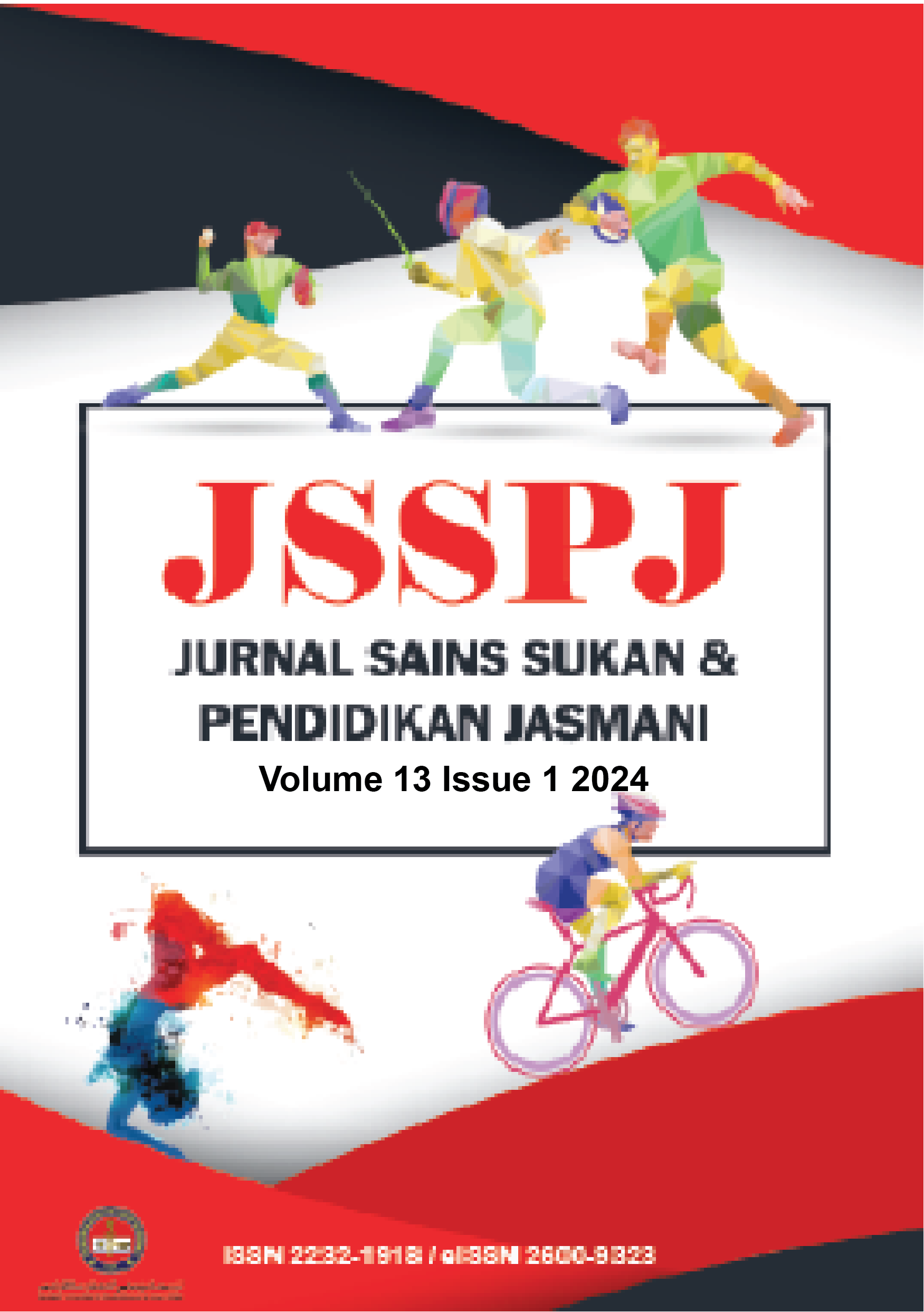Effect Of Kinesiology Tape And Sports Massage On Markers Of Exercise Induced Muscle Soreness And Muscular Power Among University Football Players
DOI:
https://doi.org/10.37134/jsspj.vol13.1.5.2024Keywords:
Kinesiology Tape (KT), Sport Massage (SM), Pain Scale (PS), Range of Motion (ROM), Power (PWR)Abstract
The aim of this research is to investigate the effects of kinesiology tape and sport massage on exercise-induced muscle soreness and muscular power in UiTM Seremban 3 football player’s post-match. This study is a quasi-experimental design This quasi-experimental study involved eleven (N=11) participants that were assigned to underwent kinesiology tape (KT) and sport massage (SM). The participants underwent taping of the lower limbs, with particular emphasis on the quadriceps, hamstrings, and gastrocnemius muscles, for both the KT and SM interventions. The participant’s pain scale and ROM were recorded at four time periods: immediately after the match, 24 hours, 48 hours, and 72 hours after the match. Power was assessed at three time periods: 24 hours, 48 hours, and 72 hours after the match. The differences in muscle soreness scores between the two groups were analysed using repeated measure ANOVA. The results indicated that both KT and SM had a significant effect on pain scale (PS), range of motion (ROM), and power (PWR) between the four-time periods (p<0.05). However, there is no significant difference in effect between KT and SM. SM and KT reduced the pain, increased range of motion, and increased power because massage generated a sense of relaxation and alleviated pain. While kinesiology tape activates inhibitory interneurons, effectively blocking pain signals carried by A-delta and C-fibres, it alleviates pain. In conclusion, KT and SM are effective to reduce muscle soreness and increase muscular power among football players.
Downloads
References
Andrýsková, A., & Lee, J. H. (2020). The guidelines for application of kinesiology tape for prevention and treatment of sports injuries. Healthcare, 8(2), 144.
Boguszewski, D., Szkoda, S., Adamczyk, J. G., & Białoszewski, D. (2014). Sports massage therapy on the reduction of delayed onset muscle soreness of the quadriceps femoris. Human movement, 15(4), 234-237.
Chang, Y. H., Chou, Y. C., Chang, Y. C., Tan, K. H., & Wu, M. H. (2022). The effects of high-intensity power training versus traditional resistance training on exercise performance. International Journal of Environmental Research and Public Health, 19(15), 9400.
Fazackerley, L., Minett, G., McLaren, S., Ward, P., Marsh, D., Burgess, D., ... & Kelly, V. (2023). The annual training and competitive calendar in elite football: a road to the holy grail?. International Journal of Strength and Conditioning, 3(1).
Joseph, L. H., Hancharoenkul, B., Sitilertpisan, P., Pirunsan, U., & Paungmalia, A. (2018). Comparison of effects between core stability training and sports massage therapy among elite weightlifters with chronic non-specific low back pain: A randomized cross-over study. Asian Journal of Sports Medicine, 9(1).
Lee, S. M., & Lee, J. H. (2018). Effect of balance taping using kinesiology tape for a hamstring muscle injury and traumatic knee pain in an amateur university football player: A case report. Medicine, 97(23), e10973.
Leivadi, S., Hernandez-Reif, M., Field, T., O'Rourke, M., D'Arienzo, S., Lewis, D., ... & Kuhn, C. (1999). Massage therapy and relaxation effects on university dance students. Journal of dance medicine & science, 3(3), 108-112.
McKeigue, M. E., Liang, M. T., Ulety, K. & Allen, T. W. (2022). “Mechanisms and treatment of delayed onset muscle soreness in athletes - a review.” Journal of Biomedical Research & Environmental Sciences, 3(7):827–32.
Slomka, K., Skowronek, T., Rzepko, M., & Król, H. (2014). Evaluation of reliability and concurrent validity of inexpensive and expensive systems used for recording maximum vertical jump performance. In ISBS-Conference Proceedings Archive.
Stojanović, E., Stojiljković, N., Stanković, R., Scanlan, A. T., Dalbo, V. J., & Milanović, Z. (2021). Game format alters the physiological and activity demands encountered during small-sided football games in recreational players. Journal of Exercise Science & Fitness, 19(1), 40-46.
Weerapong, P., Hume, P. A., & Kolt, G. S. (2005). The mechanisms of massage and effects on performance, muscle recovery and injury prevention. Sports Medicine, 35, 235-256.
Downloads
Published
Issue
Section
License
Copyright (c) 2024 Kashran Khazani, Mardiana Mazaulan, Muhamad Noor Mohamed, Nurul Ain Abu Kassim, Raja Nurul Jannat Raja Hussein , Sharifah Maimunah Syed Mud Puad

This work is licensed under a Creative Commons Attribution-NonCommercial-ShareAlike 4.0 International License.





